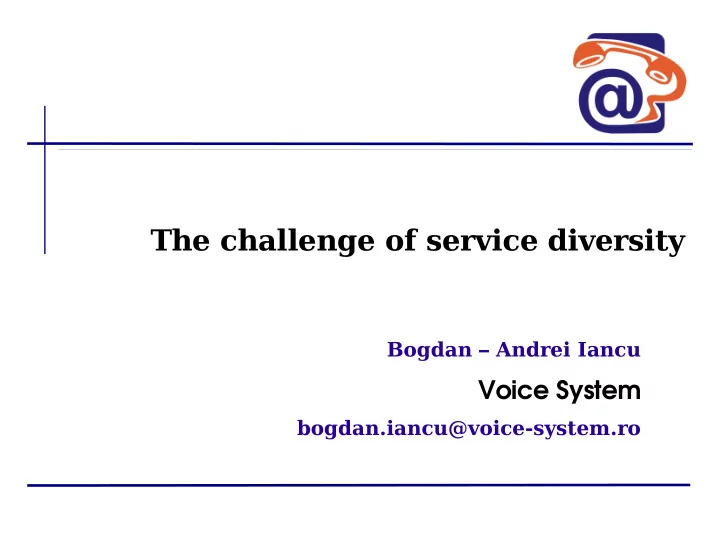

The challenge of service diversity Bogdan – Andrei Iancu Voice System bogdan.iancu@voice-system.ro
Services and solutions ● solution ≠ service ● but there is a relevant service for each solution ● solution = ∑ (services) ● tight interdependency among services (no standalone service) ● the efficiency of a solution is given by ● the number of included services (focus on the primary services) ● the complexity of service integration Voice System OpenSER Summit, Berlin 2006
“Fog of War” (I) ● each service may recursively force the usage of a new set of services ● Key question : when to stop?! Show case I – Trunking solution ● trunking ● peering ● security, group definition ● load-balancing ● failure detection, failover Voice System OpenSER Summit, Berlin 2006
“Fog of War” (II) Show case II – Residential solution ● SIP peering ● ENUM, interdomain trust, spam detection ● PSTN termination ● DID allocation, LCR, inbound and outbound ● Web interfaces ● load balancing, triggers, DB integration ● High-availability ● replication, synchronization, failover Voice System OpenSER Summit, Berlin 2006
Solution complexity Complexity Number of services Distribution factor Voice System OpenSER Summit, Berlin 2006
Distributed services ● service distribution increases the complexity of the solution exponentially with the number of services. ● it cannot be avoided because of: ● geographic distribution of subscribers and resources ● increasing load on the system ● high-availability reasons Voice System OpenSER Summit, Berlin 2006
Distributed - showcase Voice System OpenSER Summit, Berlin 2006
Distributed – show case Voice System OpenSER Summit, Berlin 2006
Distributed services (II) ● distribution can be made on several level -> you need to make a compromise between the distribution factor and overall complexity. ● it differently apply to routing logics and resources ● distribution implies bidirectional data flow: ● spread configuration and routing info ● gather CDRs, reports, statistics Voice System OpenSER Summit, Berlin 2006
Classes of solutions
Carrier grade ● trunking means high traffic and multiple peers: ● dynamic and complex routing ● load-balancing and traffic shaping ● interconnection policies ● carrier grade implies: ● service and physical distribution ● optimize performances ● data re-design ● sever security Voice System OpenSER Summit, Berlin 2006
Carrier grade (II) ● high availability is a major requirement: ● PSTN termination – auto-detection and traffic redirection ● SIP peering – re-routing based on agreement policies ● service availability – a combination of hardware/server redundancy with physical distribution ● scalability cannot be ignored Voice System OpenSER Summit, Berlin 2006
Hosted solutions ● White-label solutions – the key question is how much “white” the solution can offer? ● flexible enough to incorporate customer's own resources? ● CDR aggregation and reformatting ● reselling levels for billing ● dialing plan and security policies ● routing logics Voice System OpenSER Summit, Berlin 2006
Residential solutions ● end-user presence makes it more challenging as model and technology: ● advanced user interfaces ● NAT traversal and QoS ● devices to be used (RFC compliant) ● non-SIP service integration: SMS/MMS, PSTN&GSM, Yahoo, GTalk, Web&Email ● per-user complex routing and filtering services Voice System OpenSER Summit, Berlin 2006
Residential solutions (II) ● it is a highly open system (to the internet) ⇒ needs more protection form the outside intrusion ● complex services more protection due ⇒ vulnerabilities ● more end-user and provider specific services leads to an increased overall complexity ● in most of the case, a distributed alternative is required; the answer is not simple because of the overall complexity. Voice System OpenSER Summit, Berlin 2006
Billing solutions CDR generation/mediation in the context of advanced services (like CF). Rating plan flexibility and complexity. ● PostPaid : ● easier and affordable ● off-line processing versus no real-time call control ● PrePaid : ● complex and more expensive ● real-time call control versus intensive real-time processing. Voice System OpenSER Summit, Berlin 2006
Conclusions Avoid complexity penalties because of service handling! ● identify only the important and relevant services needed for your solution. ● it is critical to have the knowledge to properly integrate the services into your solution. ● do distribution only if really needed and only for services you have to. ● experimental solutions may work, but they do not guarantee security and performance! Voice System OpenSER Summit, Berlin 2006
Solutions Voice System's answers to these conclusions: ● “know-how” via consultancy: ● design, implementation and deployment of customized OpenSER solutions ● distributed solution ● “out-of-the box” solutions: ● Enterprise SIP Platform for service providers ● PrePaid Carrier class engine ● Far-end NAT traversal solution ● Carrier grade balancer and router Voice System OpenSER Summit, Berlin 2006
Recommend
More recommend